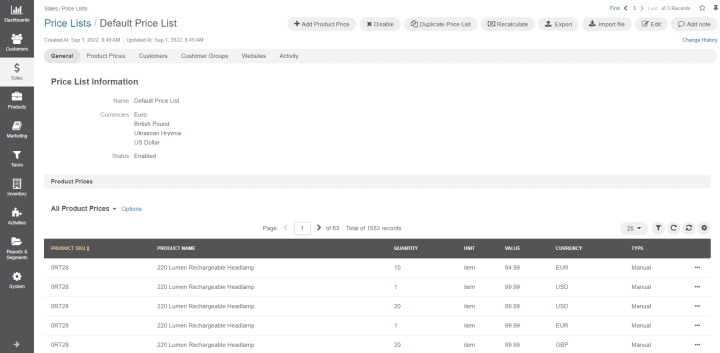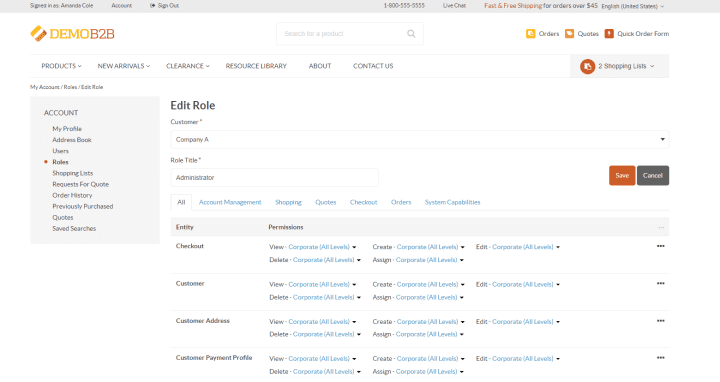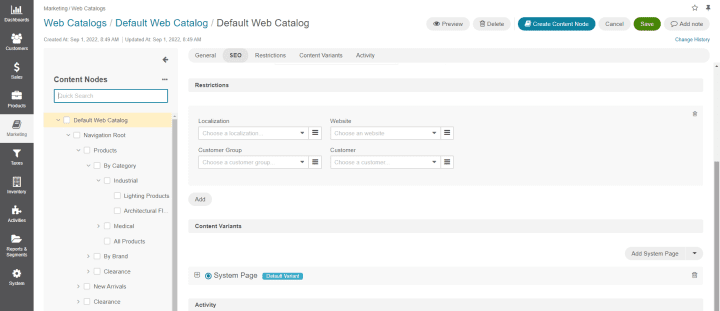Enterprise eCommerce Systems: Common Features, Functions, and Benefits
There are many eCommerce offerings on the market. It’s easy for the choices to overwhelm. But every eCommerce solution offers the same basic set of features and functions.
Here are the functions you find across most platforms. Of course, what distinguishes the products is the degree to which the functions can be customized and how they scale to the enterprise level.
Product Catalogs
Every enterprise needs the ability to create catalogs of products to offer their customers. With enterprise-grade solutions, catalogs must be capable of handling hundreds of thousands of SKUs. In B2B transactions, the negotiated contract controls the products, prices, and terms of sales. Because each contract may be different, enterprise product catalogs must be customizable.
Stay away from solutions that limit the number of SKUs or experience performance degradation as the number of SKUs and catalogs scales to meet company needs.
Price Lists

Price List Configuration in OroCommerce
Along with extensive product catalogs, enterprise-grade offerings must provide the ability to handle extensive price lists. Like catalogs, prices in B2B transactions can vary depending on the customer, the amount ordered, and any number of other variables.
Enterprise eCommerce solutions handle multiple price lists and performance doesn’t drop as the number of price lists increases.
Quoting
Quoting is just a normal part of the workflow in enterprise B2B sales negotiations. Enterprise solutions provide quoting functionality to make it easier for potential customers to contact you and request a quote for your products. This is usually the opening round of sales negotiations. Modern buyers expect this process to be digitized and modern eCommerce solutions deliver. In addition to creating a quote, the quoting function may include functions to calendar and track follow-up activities.
Tax rules
Enterprises operate in multiple jurisdictions and have complex tax accounting needs. Enterprise-level eCommerce should handle multiple taxing jurisdictions and allow you to customize the tax scenario for each customer.
Account management and control
Company hierarchies vary across enterprises. Account management and control are crucial to secure data and maintain the integrity of the system. At the same time, customers need to establish their own account controls to mirror their own organization hierarchies and approval controls.

A B2B eCommerce platform must mirror complex company hierarchies
Enterprise eCommerce solutions allow both buyers and sellers to maintain control over their accounts and customize them to suit their individual company needs.
Content management system
When choosing an enterprise eCommerce platform, you’ll find most offerings include a content management system (CMS). Ideally, this is a low-code tool. The CMS functionality comes into play when creating websites, landing pages, and downloadable assets. If the CMS offers weak functionality or requires knowledge of coding and development, you’ll need to add on a third-party CMS. Beware, this is how the total cost of ownership incrementally creeps up.

Strong CMS functionality is key for enterprise eCommerce
Localization
Enterprises commonly operate across borders and in multiple geographic locations. To meet these needs, enterprise-grade eCommerce platforms allow you to localize the content displayed. This way, products sold to clients in the US display prices in US dollars, measurements using the imperial measurement system, and all text in English. And products sold to clients in Mexico are displayed with the text in Spanish, the cost in Mexican pesos, and the dimensions using the metric system.
Multi-website support
You’ll often find many brands and sub-organizational units under the umbrella of one large enterprise organization. This requires multiple websites and digital assets to support the individual business units as well as the enterprise as a whole. This can be an update and maintenance nightmare for IT. Fortunately, most enterprise eCommerce platforms support multiple websites and front-end experiences from a unified backend. One eCommerce installation should serve all business units.
Shopping carts and wish lists
Modern B2B buyers expect a B2C-retail type experience. Even if retail sales are much different than B2B sales. These buyers are doing more than just researching products, they want to negotiate contracts, and make purchases. Robust B2B enterprise eCommerce solutions include functionality to take orders and integrate with payment processors for payment or credit agencies for sales on terms.
Because business purchases often are made with team input, a shareable wish list functionality allows buyers to share proposed purchases internal to their organization. When selecting an enterprise eCommerce system, if you don’t see this crucial functionality – move on.
Integration with other business services
How many applications does the average enterprise use? The answer ranges from 1,295 cloud services on the high end to 254 on the low end. Productiv research finds that only 45% of apps in a company are being used regularly. No matter the number of apps, platforms, and business solutions you currently use, enterprise eCommerce platforms should provide connectivity to share data appropriately.
For example, enterprise eCommerce platforms should integrate with the enterprise resource planning (ERP) system, product information management (PIM) system, warehouse management system (WMS), order management system (OMS), and third-party logistics providers. In addition, it should integrate with third-party apps to perform marketing activities like review aggregation and adding custom badges to products. When choosing an enterprise eCommerce platform, this is a make-or-break functionality.



